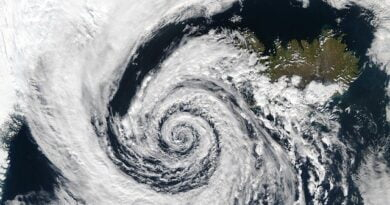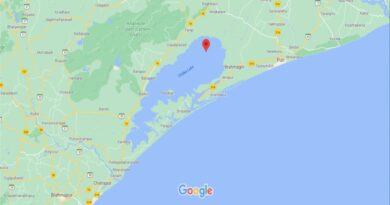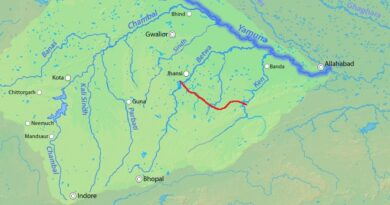El Nino and La Nina
Context:
Various parts of India, especially North India, have been experiencing a severe cold wave. Warnings for the severe cold waves have been issued in several northern states.
El Nino
The phrase “El Niño” refers to the Christ Child and was coined by fishermen along the coasts of Ecuador and Peru to describe the warming of the central and eastern pacific.
- El Niño is the name given to the occasional development of warm ocean surface waters along the coast of Ecuador and Peru. El Niño events occur irregularly at intervals of 2–7 years, although the average is about once every 3-4 years.
- When this warming occurs the usual upwelling of cold, nutrient-rich deep ocean water is significantly reduced.
- El Niño normally occurs around Christmas and usually lasts for a few weeks to a few months.
- Sometimes an extremely warm event can develop that lasts for much longer time periods. In the 1990s, strong El Niños developed in 1991 and lasted until 1995, and from fall 1997 to spring 1998.
What happens ‘normally’, at a time when there is no El Nino or La Nina?
- The warmest part of the Pacific Ocean is the region near the equator. Due to the spinning of the earth, the prevailing winds flow from east to west. This pushes the warm waters westwards, towards Indonesia.
- In the east, around the coast of South America, cool waters would normally well up. These waters are rich in nutrients and fish, and provide plenty of food for the Peruvian Fisherman.
- During a normal year it’s cool and not too rainy along the western coast of the Americas, and warm and wet in the western part of the Pacific.
During an El Nino event:
But when the trade winds die, two things happen:
- The wind-forced upwelling that draws cool water to the surface slows down, and the warm water that has pooled up in the western part of the Pacific basin starts to slosh back toward the east. And as the warmth spreads eastward, the trade winds—which are partly controlled by the temperature and air pressure differences between the two sides of the Pacific—get even weaker.
- So the chilly waters that usually help cool down the South American coast stay trapped deep below the surface, and the winds that would help cool things down stagnate. The prevailing winds across the Pacific weaken, and sometimes they can even reverse and blow the other way. This allows some of the warmer waters to move eastwards, away from Indonesia and towards South America.
Easy to explain events:
- The location of tropical storms shifts eastward during an El Niño because atmospheric moisture is fuel for thunderstorms, and the greatest amount of evaporation takes place above the ocean’s warmest water.
- Waters near the coast of South America are warmer than usual, which makes the weather in the region warmer than usual. This increases evaporation and therefore the region also sees more rain than in a typical year.
- Because the warmer waters are moving away from Indonesia, the weather here is drier than usual.
El Nino Southern Oscillation (ENSO)
It is called El Nino Southern Oscillation. In normal times, when the tropical south Pacific ocean experiences high pressure, alternatively the tropical Indian ocean experiences low pressure conditions. However, these pressure conditions are sometimes reversed, and results in low pressure in the Pacific and alternatively high pressure in the Indian ocean. This is the periodic change in pressure conditions which is referred to as the Southern Oscillation. These changes in the pressure conditions being developed in the Pacific and Indian oceans are connected with the phenomenon of El Nino. This connected phenomenon is referred to as the El Nino Southern Oscillations or the ENSO.
El Nino – Effects on India
In a normal monsoon year (without El Nino), the pressure distribution is as follows:
- The coast of Peru in South America has a higher pressure than the region near northern Australia and South East Asia.
- The Indian Ocean is warmer than the adjoining oceans and so, has relatively lower pressure. Hence, moisture-laden winds move from near the western Pacific to the Indian Ocean.
- The pressure on the landmass of India is lower than on the Indian Ocean, and so, the moisture-laden winds move further from the ocean to the lands.
If this normal pressure distribution is affected for some reason, the monsoons are affected.
El Nino Effects
- El Nino results in the rise of sea surface temperatures
- It also weakens the trade winds of the affected region
- In India, Australia, it can bring about drought conditions. This affects the crop productivity largely. It has been also observed certain times, that EL Nino may not bring drought but cause heavy rainfall. In both the cases, it causes heavy damage.
- However, in some other countries it may result in a complete reversal, i.e., excessive rainfall.
Mitigation Of Effects:
- Keeping a check on the sea surface temperatures
- Maintaining sufficient buffer stocks of food grains and ensuring their smooth supply
- Ensuring relevant support to the farmer community including economic help
- Alternative ways to be promoted such as the practice of sustainable agriculture
Measuring El Nino
Scientists, governments, and non-governmental organizations (NGOs) collect data about El Nino using a number of technologies such as scientific buoys.
- A buoy is a type of object that floats in water and is used in the middle of the seas as locators or as warning points for ships. They are generally bright (fluorescent) in color.
- These buoys measure ocean and air temperatures, currents, winds, and humidity.
- The buoys transmit data daily to researchers and forecasters around the world enabling scientists to more accurately predict El Nino and visualize its development and impact around the globe.
The Oceanic Nino Index (ONI) is used to measure deviations from normal sea surface temperatures. The Oceanic Niño Index is a measure of the departure from normal sea surface temperature in the east-central Pacific Ocean, is the standard means by which each El Nino episode is determined, gauged, and forecast.
- The intensity of El Nino events varies from weak temperature increases (about 4-5° F) with only moderate local effects on weather and climate to very strong increases (14-18° F) associated with worldwide climatic changes.
La Nina
- La Niña is a coupled ocean-atmosphere phenomenon that is the colder counterpart of El Niño, as part of the broader El Niño–Southern Oscillation (ENSO) climate pattern.
- is a coupled ocean-atmosphere phenomenon that is the colder counterpart of El Niño, as part of the broader El Niño–Southern Oscillation (ENSO) climate pattern.
- During a period of La Niña, the sea surface temperature across the equatorial Eastern Central Pacific Ocean will be lower than normal by 3 to 5 °C (5.4 to 9 °F).
- An appearance of La Niña persists for at least five months.
- It has extensive effects on the weather across the globe, particularly in North America, even affecting the Atlantic and Pacific hurricane seasons, in which more tropical cyclones occur in the Atlantic basin due to low wind shear and warmer sea surface temperatures, while reducing tropical cyclogenesis in the Pacific Ocean.
- La Niña is a complex weather pattern that occurs every few years, as a result of variations in ocean temperatures in the Equatorial Pacific.
- It occurs as strong winds blow warm water at the ocean’s surface from South America across the Pacific Ocean towards Indonesia.
- As this warm water moves west, cold water from the deep sea rises to the surface near South America.
- As a result, it is considered to be the cold phase of the broader El Niño–Southern Oscillation weather pattern, as well as the opposite of El Niño weather pattern.
- La Niña impacts the global climate and disrupts normal weather patterns, which as a result can lead to intense storms in some places and droughts in others
Impact of La Nina
- Europe: In Europe, El Nino reduces the number of autumnal hurricanes.
- La Nina tends to lead to milder winters in Northern Europe (especially UK) and colder winters in southern/western Europe leading to snow in the Mediterranean region.
- North America: It is continental North America where most of these conditions are felt. The wider effects include:
- Stronger winds along the equatorial region, especially in the Pacific.
- Favourable conditions for hurricanes in the Caribbean and central Atlantic area.
- Greater instances of tornados in various states of the US.
- South America: La Nina causes drought in the South American countries of Peru and Ecuador.
- It usually has a positive impact on the fishing industry of western South America.
- Western Pacific: In the western Pacific, La Nina increases the potential for landfall in those areas most vulnerable to their effects, and especially into continental Asia and China.
- It also leads to heavy floods in Australia.
- There are increased temperatures in Western Pacific, Indian Ocean and off the Somalian coast.
Source: National Ocean Service
You can find many articles on GEOGRAPHY (part of GS I) in our website. Go through these articles share with your friends and post your views in comment section.




